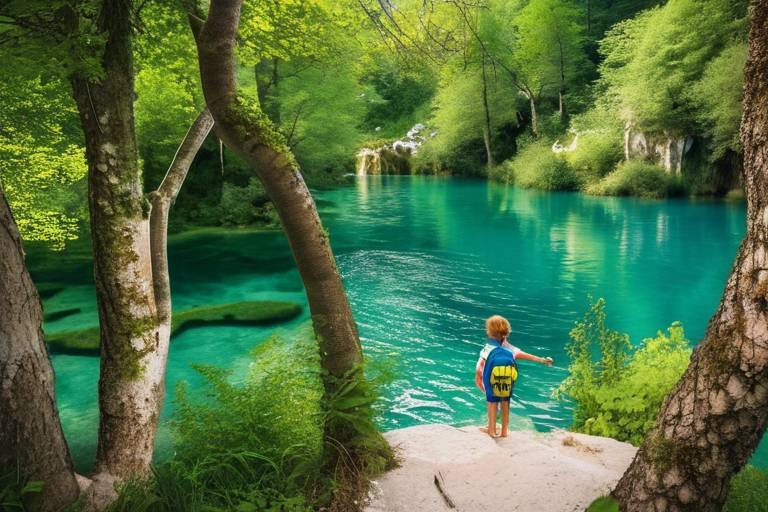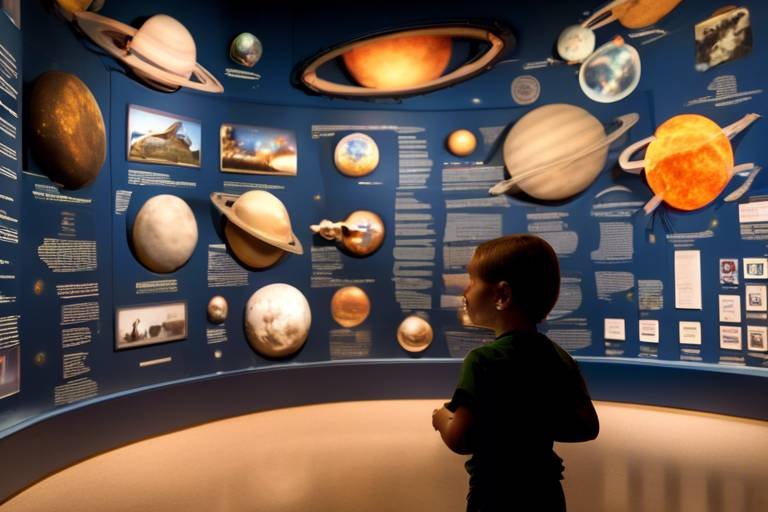Must-Visit Family Museums in the World
When it comes to creating unforgettable family memories, few experiences can rival a visit to a museum. Museums have evolved from quiet, dusty halls filled with artifacts to vibrant, interactive spaces that cater to the curious minds of all ages. In this article, we will explore a diverse selection of family-friendly museums around the globe, showcasing interactive exhibits, educational programs, and engaging activities that ensure memorable experiences for the entire family. Whether you're marveling at ancient artifacts, experimenting with science, or getting hands-on with art, these museums promise to ignite your family's imagination and foster a love for learning.
Have you ever watched your child's eyes light up with wonder at the sight of a bubbling volcano or a spinning planetarium? Interactive science museums are designed to do just that! These spaces encourage children to dive into the world of science through hands-on exhibits and experiments that captivate young minds. Imagine a place where learning about physics, chemistry, and biology isn't just a textbook exercise but an exhilarating adventure. Families can explore everything from the mysteries of the universe to the intricacies of the human body, making science not just accessible but downright exciting!
Art is a universal language, and children's art museums speak it fluently! These vibrant spaces are designed specifically for young creators, featuring interactive installations, workshops, and exhibitions that inspire creativity and self-expression. They foster a love for the arts from an early age, allowing children to explore their imaginations in a supportive environment. Whether it's painting, sculpting, or digital art, these museums offer a playground for budding artists.
One of the highlights of visiting a children's art museum is the opportunity to participate in creative workshops. Families can roll up their sleeves and engage in hands-on activities where they learn new skills and techniques while creating their own masterpieces. Imagine the joy of leaving with a unique piece of art that you made together, a tangible memory of your day spent in creativity!
Children's art museums often host exhibitions that showcase the works of young artists, providing a platform for kids to express their creativity. These exhibitions not only allow children to gain confidence in their artistic abilities but also help them appreciate the artistic talents of their peers. It's a beautiful way to celebrate creativity and community!
Another exciting feature of children's art museums is the chance to participate in collaborative art projects. Families can work together to create large-scale artworks, fostering teamwork and communication. These projects not only result in stunning displays but also create a sense of community and shared accomplishment as families bond over their artistic endeavors.
Step back in time at educational history museums, where families can explore engaging exhibits that bring history to life. These museums use immersive experiences, artifacts, and storytelling to make learning about the past enjoyable. Picture walking through a recreated ancient village or standing in front of a life-size replica of a famous historical figure. It’s like stepping into a time machine!
For those fascinated by the wonders of the natural world, natural history museums are a treasure trove of knowledge. From dinosaurs to fossils and ecosystems, these museums feature fascinating exhibits that captivate the imagination and inspire a love for nature and science. Walking through these halls is like embarking on a grand adventure through time and nature.
Families can experience interactive exhibits that educate them about biodiversity and conservation. These exhibits highlight the importance of protecting our planet's ecosystems and the fascinating creatures that inhabit them. It’s a wonderful way to instill a sense of responsibility and appreciation for the environment in young minds.
Joining family-friendly guided tours is another fantastic way to explore natural history museums. These tours offer engaging narratives and hands-on activities, allowing families to delve deeper into the museum's collections while learning about natural history in an entertaining and informative way. It’s a chance to ask questions, share laughs, and create lasting memories together.
Q: What age groups are these museums suitable for?
A: Most family-friendly museums cater to children of all ages, from toddlers to teenagers, ensuring that everyone finds something engaging and educational.
Q: Are there any costs associated with visiting these museums?
A: Admission prices vary by museum, with some offering free entry or discounted family passes. It's always a good idea to check the museum's website for the latest information.
Q: Can we participate in workshops without prior experience?
A: Absolutely! Many workshops are designed for beginners and provide all the materials and guidance needed to create something special.
Q: Are these museums accessible for families with disabilities?
A: Most family-friendly museums strive to be inclusive and accessible. It’s best to check their website or contact them directly for specific accessibility information.

Interactive Science Museums
When it comes to sparking a child's curiosity, are the ultimate playgrounds of knowledge! Imagine walking into a space where the walls are alive with the energy of hands-on exhibits and captivating experiments, all designed to make learning about physics, chemistry, and biology not just informative but downright exhilarating. These museums are like treasure chests filled with wonders waiting to be discovered, making them perfect destinations for families looking to ignite a passion for science in their little ones.
One of the most exciting aspects of these museums is their ability to transform complex scientific concepts into engaging and accessible experiences. For instance, children can step into the shoes of a scientist as they conduct experiments, observe chemical reactions, and even explore the mysteries of the universe through interactive displays. It’s like having a front-row seat to the magic of science! Here, learning is not confined to textbooks; instead, it leaps off the page and into the hands of eager young minds.
Many interactive science museums feature themed areas that focus on different branches of science. For example, you might find sections dedicated to:
- Physics: Where kids can experiment with gravity, motion, and energy through fun activities like building roller coasters or launching rockets.
- Chemistry: Offering safe, hands-on experiments that allow children to mix colorful substances and watch amazing reactions unfold.
- Biology: Showcasing the wonders of life, from the tiniest microorganisms to the vast ecosystems that support them.
But the fun doesn't stop there! Many of these museums also host educational programs and workshops that cater to various age groups. These programs often include:
- Live demonstrations: Where experts showcase exciting experiments that leave kids in awe.
- Science camps: Offering immersive experiences during school breaks, allowing kids to dive deep into specific scientific fields.
- Family science nights: Fun-filled evenings that encourage families to explore exhibits together while engaging in collaborative projects.
Visiting an interactive science museum is not just about observing; it’s about getting involved! Families can participate in challenges, solve puzzles, and even engage in friendly competitions that foster teamwork and critical thinking skills. These experiences create lasting memories, as families bond over their shared discoveries and triumphs.
Moreover, many interactive science museums are equipped with state-of-the-art technology that enhances the learning experience. From virtual reality simulations that transport visitors to distant planets to augmented reality exhibits that bring historical scientific discoveries to life, technology plays a crucial role in making science accessible and exciting for all ages. It’s like stepping into a sci-fi movie where the possibilities are endless!
So, if you're looking for a way to make science fun and engaging for your family, an interactive science museum should be at the top of your list. Whether you’re launching a homemade rocket, exploring the human body, or delving into the depths of the ocean, these museums offer experiences that are not only educational but also incredibly enjoyable. Prepare to be amazed, inspired, and, most importantly, to have a blast while learning!
Q: What age groups are interactive science museums suitable for?
A: Interactive science museums cater to all age groups, with exhibits designed specifically for children, teenagers, and adults. Many museums have dedicated areas for younger children to explore safely.
Q: Are the exhibits hands-on?
A: Yes! One of the main attractions of interactive science museums is that most exhibits are hands-on, allowing visitors to engage directly with the science being presented.
Q: Do I need to make reservations?
A: It depends on the museum. Some popular museums may require advance reservations, especially for special events or workshops, so it's best to check their website before your visit.
Q: Are there any additional costs for workshops or programs?
A: Many museums include workshops and programs in the admission price, but some special events may have additional fees. Always check the museum's website for detailed information.

Children's Art Museums
Children's art museums are magical places where creativity knows no bounds! These vibrant spaces are designed specifically for young minds, offering a plethora of interactive installations and workshops that ignite passion for the arts. Imagine walking into a world where every corner invites you to explore, create, and express yourself. From colorful murals to hands-on art activities, these museums are a haven for families looking to foster a love for creativity from an early age.
One of the most exciting aspects of children's art museums is the creative workshops they offer. Families can dive into a variety of activities, such as painting, sculpting, and even digital art. These workshops are not just about making art; they are about learning new skills and techniques while having a blast together. Picture your child covered in paint, giggling as they create their own masterpiece to take home. It’s not just art; it’s a memory in the making!
In these workshops, children are encouraged to explore their imagination. Experienced instructors guide them through the process, ensuring that every child feels confident in their abilities. Whether it’s molding clay into fantastical creatures or experimenting with colors on canvas, the emphasis is on fun and self-expression. This hands-on approach allows kids to see that art is not just something to admire; it’s something they can create themselves!
Another highlight of children's art museums is the exhibitions that showcase the works of young artists. These exhibitions provide a platform for children to display their creativity, allowing them to gain confidence and appreciate the talents of their peers. It's a delightful experience to walk through a gallery filled with colorful, imaginative works created by kids just like them! This not only validates their efforts but also inspires them to continue creating.
Moreover, many children's art museums feature collaborative art projects that encourage teamwork and communication among families. These projects allow families to come together to create large-scale artworks, fostering a sense of community and shared accomplishment. Imagine the joy of seeing your family’s collective creation displayed in the museum, a beautiful representation of your teamwork and creativity. It’s a wonderful way to bond while making art!
Overall, children's art museums are essential for nurturing creativity and imagination in young minds. They provide a unique environment where learning and fun go hand in hand. So next time you’re looking for a family outing, consider visiting one of these enchanting museums. You’ll leave with not just art, but cherished moments and a deeper appreciation for the world of creativity!
| Question | Answer |
|---|---|
| What age group are children's art museums suitable for? | Children's art museums typically cater to ages 2-12, but many activities are enjoyable for all ages! |
| Do we need to book in advance for workshops? | It's recommended to book in advance, especially for popular workshops, to ensure your spot! |
| Are there any fees for entry? | Most children's art museums have a nominal entry fee, while some may offer free admission on certain days. |
| Can adults participate in the workshops? | Absolutely! Many workshops encourage adult participation, making it a fun family activity. |

Creative Workshops
When it comes to engaging the artistic spirit of children, at children's art museums are nothing short of magical. Imagine a vibrant space filled with colors, textures, and the sounds of laughter as families come together to explore their creativity. These workshops are designed to be interactive and fun, allowing children to unleash their imaginations while learning new skills. Whether it's painting, sculpting, or even digital art, there's something for every budding artist.
One of the most exciting aspects of these workshops is the opportunity for families to work together. Picture this: a parent and child side by side, both covered in paint, collaborating on a masterpiece that reflects their unique bond. This shared experience not only fosters creativity but also strengthens family ties. It's a reminder that art is not just about the final product, but the journey of creating it together.
In these workshops, participants can expect to:
- Learn New Techniques: From basic drawing skills to advanced painting methods, children and their parents can gain insights from skilled instructors who guide them through the creative process.
- Use Quality Materials: Unlike typical art classes, these workshops often provide high-quality art supplies, ensuring that each creation is something to be proud of.
- Explore Different Mediums: Families can experiment with various materials, such as clay, watercolor, or even mixed media, broadening their artistic horizons.
Moreover, many museums host themed workshops that align with current exhibitions. For example, if the museum is showcasing a collection of Impressionist paintings, families might have the chance to learn about this art movement while creating their own Impressionist-style works. This integration of education and hands-on experience makes for a memorable outing.
Additionally, workshops often culminate in an exhibition where participants can display their creations. This not only gives children a sense of accomplishment but also boosts their confidence as they share their art with others. Imagine the pride on a child's face when they see their artwork hanging on a wall, surrounded by the creations of their peers. It's a celebration of creativity and community that leaves a lasting impression.
So, if you're looking for a unique way to bond with your family while nurturing creativity, consider joining a workshop at a children's art museum. It's an adventure that promises to inspire and ignite the artistic passions within every family member!
Q: What age groups are the creative workshops suitable for?
A: Most creative workshops cater to a wide range of ages, typically from toddlers to teenagers. Some workshops may have specific age requirements, so it's best to check with the museum in advance.
Q: Do I need to register in advance for workshops?
A: Yes, many museums require advance registration for workshops due to limited space. It's advisable to reserve your spot early to avoid disappointment.
Q: Are materials provided for the workshops?
A: Absolutely! Most children's art museums provide all the necessary materials for the workshops, ensuring that families can focus on creating without worrying about bringing supplies.
Q: Can parents participate in the workshops?
A: Yes! These workshops are designed for family participation, encouraging parents and children to work together and enjoy the creative process.

Exhibitions for Young Artists
Visiting exhibitions that showcase the works of young artists is nothing short of a magical experience. These exhibitions serve as a vibrant platform for children to express their creativity, and they often leave a lasting impression on both the artists and the viewers. Imagine walking into a gallery filled with colorful paintings, intricate sculptures, and innovative installations created by kids. It’s like stepping into a world where imagination knows no bounds!
These exhibitions not only allow young artists to display their talents but also help them gain confidence in their abilities. When children see their artwork displayed proudly on the walls, it can ignite a sense of accomplishment and pride that fuels their passion for creativity. Moreover, these events often encourage a community spirit, as families and friends gather to support the young creators. It’s a celebration of talent, and the atmosphere is usually buzzing with excitement as people discuss the pieces on display.
One of the most exciting aspects of these exhibitions is the variety of art forms represented. You might see everything from traditional paintings and drawings to mixed media installations and digital art. Each piece tells a story, reflecting the unique perspective of the young artist. For instance, a child might create a painting that captures their favorite memory from a family vacation or a sculpture that represents their dreams for the future. This diversity not only enriches the experience for visitors but also fosters a deeper appreciation for the different ways art can be expressed.
Many of these exhibitions also incorporate interactive elements, allowing visitors to engage with the art in unique ways. For example, some galleries might have dedicated spaces where families can participate in hands-on activities related to the artworks on display. This could range from collaborative mural painting to crafting workshops, where children can create their own masterpieces inspired by the exhibition. Such activities not only enhance the experience but also make art accessible and fun for everyone involved.
In addition to showcasing the artwork, many exhibitions for young artists feature workshops and talks led by experienced artists. These sessions can be incredibly inspiring, as they provide children with the opportunity to learn new techniques and gain insights into the creative process. Imagine a young artist learning about color theory or the basics of sculpture from someone who has dedicated their life to the craft! It’s these interactions that can truly spark a lifelong love for the arts.
As you can see, exhibitions for young artists are more than just displays of talent; they are vibrant celebrations of creativity, community, and education. They create an environment where children feel empowered to express themselves and explore their artistic potential. So, the next time you come across one of these exhibitions, don’t hesitate to take your family. You might just find that it’s one of the most enriching experiences you can share together!
- What age group can participate in young artist exhibitions? Most exhibitions welcome artists from preschool age up to high school, providing a platform for a wide range of talents.
- How can my child get involved in showcasing their art? Check with local art museums or community centers for upcoming exhibitions and submission guidelines. Many places host open calls for young artists.
- Are these exhibitions free to attend? While many exhibitions are free, some may charge a small entry fee. It’s best to check the specific exhibition details beforehand.
- Can families participate in workshops during the exhibition? Yes! Many exhibitions offer workshops designed for families to engage in creative activities together.

Collaborative Art Projects
Collaborative art projects are an absolute gem in the world of children's art museums! Imagine a vibrant space bustling with laughter, creativity, and the sound of brushes dancing across canvases. These projects are not just about creating art; they are about building connections and fostering teamwork among families. When families come together to work on a large-scale artwork, they embark on a journey that goes beyond mere painting or crafting. They share ideas, negotiate colors, and even debate the best way to express their collective vision.
One of the most exciting aspects of these projects is the community spirit they cultivate. As families collaborate, they learn to communicate effectively, respect each other's opinions, and appreciate diverse perspectives. This dynamic process is akin to a well-rehearsed orchestra, where each member plays a unique role yet contributes to a harmonious final piece. The end result is not just a stunning artwork but also a shared sense of accomplishment that can strengthen family bonds.
In many children's art museums, these collaborative projects are often themed, allowing families to explore various subjects together. For instance, a project might focus on environmental themes, where participants use recycled materials to create sculptures that represent wildlife or natural habitats. This not only sparks creativity but also instills a sense of responsibility towards the planet. Families might find themselves discussing the importance of conservation while they work, making the experience both educational and enjoyable.
Moreover, these projects are designed to be inclusive, welcoming participants of all ages and skill levels. Whether you're a budding artist or someone who hasn't picked up a paintbrush since childhood, there's a place for you in these collaborative endeavors. The joy lies in the process, not just the product. Families often leave with not just a piece of art but also cherished memories and a newfound appreciation for each other's creativity.
To further enhance the experience, many museums provide guidance from professional artists who facilitate these collaborative projects. These artists help families navigate the creative process, offering tips and techniques while encouraging them to express their unique styles. This mentorship aspect adds another layer of value, turning a simple art project into a rich learning experience.
In essence, collaborative art projects in children's art museums are a beautiful blend of creativity, education, and family bonding. They remind us that art is not just about individual expression but also about coming together to create something truly special. So, next time you visit a museum, don’t miss out on the chance to roll up your sleeves and dive into a collaborative art project. It's an experience that will leave a lasting impression on both your heart and your home!
- What age groups can participate in collaborative art projects?
Collaborative art projects are designed for all ages, making them perfect for families with children of different age groups. - Do we need to bring our own materials?
No, most museums provide all necessary materials for the projects, ensuring that everyone can participate without any prior preparation. - How long do these projects usually take?
The duration can vary, but most collaborative art projects last between 1 to 3 hours, allowing ample time for creativity and fun. - Are there any fees associated with participating in these projects?
Participation fees may vary by museum, so it’s best to check their website or contact them directly for specific details.

Educational History Museums
Step back in time at , where families can explore engaging exhibits that breathe life into the past. Imagine walking through the halls of a museum, surrounded by artifacts that tell stories of ancient civilizations, revolutionary events, and cultural transformations. These museums serve as portals to different eras, allowing visitors of all ages to experience history in a way that is both educational and entertaining.
One of the most captivating aspects of educational history museums is their ability to transform dry facts into immersive experiences. Through interactive exhibits, families can engage with history like never before. For instance, some museums offer virtual reality experiences that transport you to significant historical events, making you feel as though you are actually part of the action. Can you imagine standing on the battlefield during a pivotal moment in history or witnessing the signing of a crucial document? These experiences spark curiosity and make learning about the past not just informative, but exhilarating!
Moreover, many educational history museums feature hands-on activities that encourage visitors to participate actively. From archaeological digs to reenactments of historical events, these activities allow families to roll up their sleeves and dive into history. Children can learn about ancient cultures by trying their hand at traditional crafts or exploring replicas of historical sites. This hands-on approach not only makes learning fun but also helps children retain information more effectively.
Another appealing aspect is the storytelling element that many museums incorporate into their exhibits. Curators often craft narratives that connect visitors to the artifacts on display, making history relatable and personal. For example, you might find exhibits that highlight the daily lives of people from different eras, complete with audio guides that narrate their stories. This storytelling approach fosters a deeper understanding of historical events and the people behind them.
As you plan your visit to an educational history museum, consider checking out their special programs and events. Many museums host workshops, lectures, and themed days that can enhance your experience. These events often cater to families, providing opportunities to learn together in a fun and engaging environment. Here’s a quick overview of what you might find:
| Event Type | Description | Age Group |
|---|---|---|
| Workshops | Hands-on activities related to specific historical themes. | All ages |
| Lectures | Educational talks by historians and experts. | Teens and adults |
| Themed Days | Special events focusing on particular historical topics. | All ages |
In conclusion, educational history museums offer a treasure trove of experiences that can enrich your family's understanding of the past. They transform the way we view history, making it accessible and enjoyable for everyone. So, gather your family, choose a museum, and embark on a journey through time that promises to be both enlightening and unforgettable!
- What should I expect at an educational history museum?
Expect interactive exhibits, hands-on activities, and engaging storytelling that brings history to life for all ages. - Are educational history museums suitable for young children?
Absolutely! Many museums offer programs and exhibits designed specifically for younger audiences. - How can I make the most of my visit to a history museum?
Plan ahead by checking the museum's website for special events, guided tours, and hands-on activities that suit your family's interests.

Natural History Museums
Uncover the wonders of the natural world at , where fascinating exhibits on dinosaurs, fossils, and ecosystems await you. These museums are like treasure chests filled with the stories of our planet, showcasing the incredible diversity of life that has existed throughout history. Imagine walking through a hall lined with towering dinosaur skeletons, their bones telling tales of a time long gone. It's not just about looking; it's about experiencing and feeling the connection to the Earth and its past.
One of the most captivating aspects of natural history museums is their ability to inspire a love for nature and science in visitors of all ages. From the moment you step inside, you are greeted by the sights and sounds of nature, with interactive displays that beckon you to learn more. Whether you're a curious child or an inquisitive adult, these museums offer something for everyone. You might find yourself marveling at the intricate details of a butterfly's wings or the sheer size of a woolly mammoth. Each exhibit is a doorway to a new world, inviting you to explore and discover.
Many natural history museums also prioritize education and conservation, offering programs that help visitors understand the importance of protecting our planet. For example, you might encounter interactive exhibits that educate families about biodiversity and conservation. These exhibits often highlight the delicate balance of ecosystems and the fascinating creatures that inhabit them. They serve as a reminder that we all share this planet and have a role in preserving its beauty for future generations.
Additionally, family-friendly guided tours are a fantastic way to deepen your understanding of the exhibits. These tours often feature engaging narratives and hands-on activities, allowing families to explore the museum's collections while learning about natural history in an entertaining and informative way. Imagine walking alongside a knowledgeable guide who brings the exhibits to life with stories and facts that spark your curiosity. It's like having a personal storyteller who makes history feel relevant and exciting.
To give you an idea of what to expect, here's a quick overview of some popular features you might find at natural history museums:
| Feature | Description |
|---|---|
| Dinosaur Exhibits | Life-sized skeletons and models that showcase the diversity of dinosaur species. |
| Fossil Displays | Rare fossils that tell the story of life on Earth millions of years ago. |
| Interactive Learning Stations | Hands-on activities that engage visitors in scientific concepts related to nature. |
| Nature Trails | Outdoor exhibits that allow families to explore local ecosystems and wildlife. |
In conclusion, natural history museums are not just places to observe; they are vibrant spaces that encourage exploration, learning, and appreciation for our planet. Whether you're gazing at the majestic skeleton of a T-rex or participating in a workshop about conservation, these museums provide enriching experiences that can ignite a passion for science and nature in every family member. So, the next time you're planning a family outing, consider visiting a natural history museum and embark on an adventure that promises to be both educational and fun!
Q1: What age group is best suited for natural history museums?
A1: Natural history museums cater to all ages, making them ideal for families. Children, teens, and adults can all find something engaging and educational.
Q2: Are there any interactive exhibits for kids?
A2: Yes! Many natural history museums feature interactive exhibits designed specifically for children, allowing them to engage with the material in a hands-on way.
Q3: How can we make the most of our visit to a natural history museum?
A3: To maximize your experience, consider joining a guided tour, participating in workshops, and allowing plenty of time to explore the exhibits at your own pace.
Q4: Do natural history museums have special events or programs?
A4: Yes, many museums host special events, workshops, and educational programs throughout the year. Check their website for the latest offerings!

Interactive Exhibits on Biodiversity
Explore a diverse selection of family-friendly museums around the globe, showcasing interactive exhibits, educational programs, and engaging activities that cater to visitors of all ages, ensuring memorable experiences for the entire family.
Discover the world of science through hands-on exhibits and experiments that captivate young minds and encourage curiosity, making learning about physics, chemistry, and biology exciting and accessible for families.
Explore vibrant art museums designed specifically for children, featuring interactive installations, workshops, and exhibitions that inspire creativity and self-expression while fostering a love for the arts from an early age.
Engage in creative workshops offered by children's art museums, where families can participate in hands-on activities, learning new skills and techniques while creating their own masterpieces to take home.
Visit exhibitions that showcase the works of young artists, providing a platform for children to express their creativity and gain confidence while appreciating the artistic talents of their peers.
Participate in collaborative art projects that encourage teamwork and communication among families, allowing them to create large-scale artworks together, fostering a sense of community and shared accomplishment.
Step back in time at educational history museums, where families can explore engaging exhibits that bring history to life through immersive experiences, artifacts, and storytelling, making learning about the past enjoyable.
Uncover the wonders of the natural world at natural history museums, featuring fascinating exhibits on dinosaurs, fossils, and ecosystems that captivate the imagination and inspire a love for nature and science.
One of the most exciting aspects of visiting a natural history museum is the opportunity to explore . These exhibits are designed to immerse families in the fascinating world of ecosystems and the myriad of life forms that inhabit our planet. Imagine stepping into a vibrant rainforest, where you can hear the sounds of chirping birds and rustling leaves, or walking through a simulated coral reef teeming with colorful fish. This sensory experience not only captivates the imagination of children but also educates them about the delicate balance of nature.
Many museums feature interactive displays that allow visitors to engage directly with the content. For instance, you might find touch screens that provide information about different species, or even augmented reality experiences where you can see how certain animals adapt to their environments. These hands-on interactions help children grasp complex concepts like ecosystem dynamics and conservation efforts in a fun and memorable way.
In addition to the exhibits, many museums also offer workshops and guided tours focused on biodiversity. These programs often include:
- Live demonstrations of animal behaviors.
- Interactive games that teach about food chains and habitats.
- Opportunities to participate in citizen science projects.
Such activities not only make learning enjoyable but also foster a sense of responsibility towards the environment. Families leave these exhibits not just with knowledge, but with a newfound appreciation for the natural world and the importance of protecting it.
Join family-friendly guided tours that offer engaging narratives and hands-on activities, allowing families to explore the museum's collections while learning about natural history in an entertaining and informative way.
Q: What age groups are these museums suitable for?
A: Most family-friendly museums cater to a wide range of age groups, from toddlers to teenagers, ensuring that there are activities and exhibits suitable for everyone.
Q: Are there any costs associated with visiting these museums?
A: While many museums have free admission days, others may charge a fee. It's best to check the museum's website for specific pricing information and any available discounts.
Q: Do these museums offer educational programs?
A: Yes, many museums offer educational programs, workshops, and guided tours designed to enhance the learning experience for families.
Q: Can we take photos inside the museums?
A: Photography policies vary by museum. Some allow photography without flash, while others may have restrictions. Always check the guidelines before your visit.

Family-Friendly Guided Tours
Explore a diverse selection of family-friendly museums around the globe, showcasing interactive exhibits, educational programs, and engaging activities that cater to visitors of all ages, ensuring memorable experiences for the entire family.
Discover the world of science through hands-on exhibits and experiments that captivate young minds and encourage curiosity, making learning about physics, chemistry, and biology exciting and accessible for families.
Explore vibrant art museums designed specifically for children, featuring interactive installations, workshops, and exhibitions that inspire creativity and self-expression while fostering a love for the arts from an early age.
Engage in creative workshops offered by children's art museums, where families can participate in hands-on activities, learning new skills and techniques while creating their own masterpieces to take home.
Visit exhibitions that showcase the works of young artists, providing a platform for children to express their creativity and gain confidence while appreciating the artistic talents of their peers.
Participate in collaborative art projects that encourage teamwork and communication among families, allowing them to create large-scale artworks together, fostering a sense of community and shared accomplishment.
Step back in time at educational history museums, where families can explore engaging exhibits that bring history to life through immersive experiences, artifacts, and storytelling, making learning about the past enjoyable.
Uncover the wonders of the natural world at natural history museums, featuring fascinating exhibits on dinosaurs, fossils, and ecosystems that captivate the imagination and inspire a love for nature and science.
Experience interactive exhibits that educate families about biodiversity and conservation, highlighting the importance of protecting our planet's ecosystems and the fascinating creatures that inhabit them.
Join family-friendly guided tours that offer engaging narratives and hands-on activities, allowing families to explore the museum's collections while learning about natural history in an entertaining and informative way. These tours are designed to be interactive, ensuring that every family member, from the youngest to the oldest, stays engaged. Imagine walking through a dimly lit hall filled with dinosaur skeletons, while a knowledgeable guide shares thrilling stories about these ancient giants. It's like stepping into a time machine!
During these tours, families can expect:
- Interactive Learning: Many guides incorporate quizzes and fun facts that encourage children to think critically and ask questions.
- Hands-On Experiences: Some tours include opportunities to touch fossils or examine artifacts closely, which can spark a sense of wonder and curiosity.
- Age-Appropriate Content: Guides tailor their presentations to the age of the participants, ensuring that the information is accessible and engaging for everyone.
Moreover, these tours often provide a chance for families to bond over shared experiences. As you walk through the exhibits, you might find yourselves discussing what you’ve learned, or laughing together over a particularly funny anecdote shared by your guide. It’s not just about observing; it’s about participating in the adventure of discovery.
To make the most of your guided tour experience, consider the following tips:
- Arrive Early: This allows you to get settled and ensures you don’t miss any important introductions or background information.
- Ask Questions: Encourage your kids to ask questions during the tour. This not only keeps them engaged but also enhances their understanding of the subject matter.
- Take Notes: If your kids are old enough, have them jot down interesting facts or thoughts. This can lead to further discussions later on!
In conclusion, family-friendly guided tours are an excellent way to dive deep into the wonders of natural history while creating lasting memories. So, pack your bags, grab your family, and get ready for an educational adventure that’s sure to be a hit!
| Question | Answer |
|---|---|
| What age groups are the guided tours suitable for? | Most guided tours are designed for all age groups, with content tailored to ensure everyone can enjoy and learn. |
| Do I need to book tours in advance? | It is recommended to book in advance, especially during peak tourist seasons, to secure your spot. |
| Are the tours wheelchair accessible? | Most museums strive to be inclusive, and many guided tours are wheelchair accessible. It's best to check with the museum beforehand. |
Frequently Asked Questions
- What are some of the best family-friendly museums around the world?
There are countless amazing family-friendly museums globally, but some standout options include the Exploratorium in San Francisco, the Children's Museum of Indianapolis, and the Natural History Museum in London. Each of these museums offers interactive exhibits and engaging activities that cater to all ages, making them perfect for family visits.
- How can I make the most of our visit to a museum with kids?
To maximize your experience, consider planning ahead! Check the museum's website for family programs, workshops, and special exhibits. Arrive early to avoid crowds, and don’t forget to bring snacks and water. Engaging your kids by asking questions about exhibits can also enhance their learning experience and keep them interested.
- Are there any age restrictions for workshops at children's art museums?
Most children's art museums welcome kids of all ages to their workshops. However, some activities may be better suited for specific age groups. It’s a good idea to check the museum's website or contact them directly to find out what’s appropriate for your child’s age and skill level.
- What should we wear when visiting a natural history museum?
Comfort is key! Wear comfortable shoes since you’ll likely be walking a lot. Dress in layers, as museums can vary in temperature. If you plan to visit interactive exhibits, consider wearing clothes that can get a bit messy!
- Can we bring food and drinks into the museum?
Policies on food and drinks vary by museum. Some allow snacks and water bottles, while others have designated eating areas or cafes. It’s best to check the museum's rules in advance to avoid any surprises!
- Are guided tours suitable for families with young children?
Absolutely! Many museums offer family-friendly guided tours that are designed to engage young visitors. These tours often include interactive elements and storytelling, making them fun for kids and adults alike!
- How can I encourage my child’s interest in art and history after our museum visit?
Keep the excitement alive by discussing what you saw and learned at the museum. You could also visit local art galleries, watch documentaries, or even start a small project at home related to what inspired them. Encouraging creativity through art supplies or history-themed games can also be a hit!



















